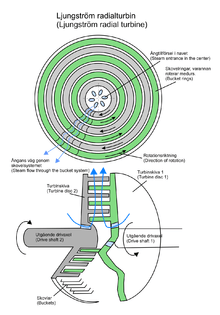Ljungström turbine

The Ljungström turbine is a steam turbine innovated circa 1908 by the Swedish brothers Birger (1872–1948) and Fredrik Ljungström (1875–1964). It is also known as the STAL turbine, from the company name STAL (Swedish: Svenska Turbinfabriks Aktiebolaget Ljungström).
Functionality
The machine is flowed through steam in radial direction from the inside to the outside and consists of two halves that rotate against each other. As a result, each rotor blade of the one turbine half serves simultaneously as the guide blade of the other half. The different direction of rotation of the two halves is either compensated by a gearbox connected downstream or by separate generators during the generation of electrical power. The Ljungström turbine can either be used on a condenser or else for the supply of a district heating grid and is thus flexible to use. It was therefore used in large industrial complexes, which could use both the exhaust of this engine for combined heat and power as well as its electric energy. The functionality has been employed for several power plants.
In principle, the maximum power is about 32 MW, since the two turbine halves can not be constructed as large as desired. Coupled with a Parsons turbine, its output can be increased to 50 MW. Since the current steam power plants have a significantly higher performance, the Ljungström turbine is generally no longer applied today.
Gallery

 Ljungström 50 MW electric generator unit for power station in Västerås (1932)
Ljungström 50 MW electric generator unit for power station in Västerås (1932) Turbine rotor of the same turbine (50 MW)
Turbine rotor of the same turbine (50 MW) A discarded Ljungström turbine of Ilseder Hütte
A discarded Ljungström turbine of Ilseder Hütte A rotor for a Ljungström turbine with internal radial and external axial blading
A rotor for a Ljungström turbine with internal radial and external axial blading
The inventors
The Ljungström brothers were creative, time-typical inventors personalities of the 19th century. They not only named the turbine type, but also an early form of a bicycle.
Bibliography
- Sigvard Strandh: Die Maschine: Geschichte, Elemente, Funktion. Ein enzyklopädisches Sachbuch", Herder Verlag, 1980. ISBN 3-451-18873-2 (Ljungströmturbine, pp. 133–135, Svea-Bike, p. 220 and Fig. 221)
External links
| Wikimedia Commons has media related to Category:Ljungström turbines. |
- Article in Swedish to the Ljungströmturbine
- Swedish investions by the Swedish Institute
- STAL-turbin till Tekniska Museet by Professor Carl-Göran Nilson at http://digitalamodeller.se/